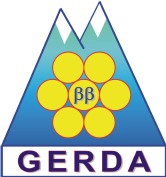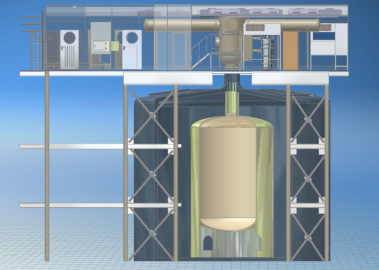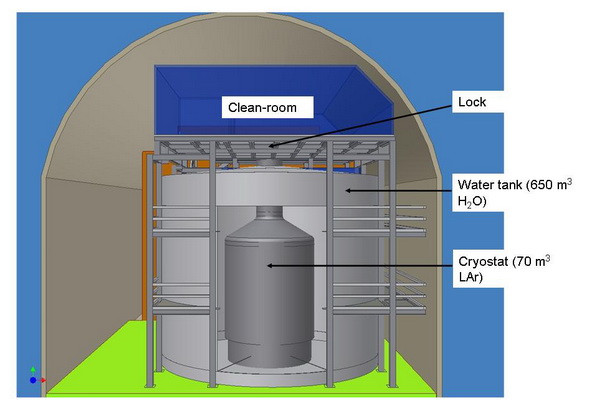
Research: GERDA
The Search for Neutrinoless Double Beta Decay
Neutrino oscillations, as studied with solar and reactor neutrinos, are sensitive to the differences of the squared masses of the neutrino mass eigenstates (Δm2). Neutrinoless double beta decay, in contrast, can yield information on the absolute neutrino mass scale. It violates lepton number conservation which is possible only if neutrinos are their own anti-particles (i.e. Majorana particles). The experimental observation of such fundamental particle – anti-particle symmetry would corroborate theoretical models which explain the smallness of neutrino masses and would shed light on the mechanism how to generate the present matter dominance of the Universe.
The GERmanium Detector Array (GERDA), searching for the neutrinoles double beta decay of 76Ge, is currently in its final phase of construction in the Laboratori Nazionali del Gran Sasso, INFN, Italy. It is implementing a new shielding concept by operating bare Ge diodes - enriched in 76Ge in high purity liquid argon supplemented by a water shield. The aim of GERDA is in a first phase to verify or refute the recent claim of discovery of neutrinoless double beta decay, and, in a second phase, to achieve a background of 1·10-3 cts/(kg·keV·years) at Qββ which is two orders of magnitude lower than recent experiments. After an exposure of 100 kg years and the said background index, half-lives up to 2·1026 years can be probed at 90% confidence level corresponding to a range of the effective neutrino mass of <0.09-0.29 eV. The GERDA experimental setup serves as well to develop and test the experimental techniques for a possible future one ton experiment with sensitivity in the 10 meV mass range.
With the delivery of the low-background steel cryostat on 6 March 2008 to hall A of the LNGS, the integration of the Gerda experimental installation commenced. The construction of the water tank started in April and was completed in July. Subsequently the Gerda building has been erected and the clean room on top of it will be completed by spring 2009. An artist’s view of the GERDA installation is shown in the figure below.

Fig. 1: An Artist’s view of the GERDA installation at the Laboratori Nazionali del Gran Sasso, Italy.
Phase I of GERDA encompasses the operation of about 18 kg of enriched 76Ge detectors, used in the previous Heidelberg-Moscow and IGEX experiments as well as 15 kg of natural germanium detectors. All diodes have been refurbished at the manufacturer, and mounted and characterized in their low-mass detector assembly in the GERDA Underground Detector Laboratory (GDL) at LNGS. While standard coaxial p-type detectors are used in phase I, novel detectors with advanced single-site / multi-site event discrimination are foreseen for phase II. Highly segmented n-type and unsegmented BEGe-like p-type detectors are currently under evaluation. In addition, an R&D program is pursued to study the simultaneous detection of scintillation light of the liquid argon which will be used as cryogenic cooling and shielding medium in order to identify and discriminate background events which dissipate part of their energy in the liquid argon.
To meet the challenging background requirements, all detector components are radio assayed to meet specified radio purity limits. Major efforts went therefore into material selection and quality assurance by low-level germanium spectrometry and radon emanation measurements of all detector components. A major challenge is the required low radon emanation rate of the cryostat, the cryogenic infrastructure as well as all components of the lock system. Radon which is produced far from the detector array can travel from its location of production close to the germanium detectors and generate background events which are miss-identified as signal events. The overall radon content in the 70 m3 of liquid argon fill of the cryostat should not exceed few tens of mBq in order not to exceed the specified background index. The experimental technique developed for this purpose is to fill the cryostat with purified nitrogen, extract several days later a large gas volume and freeze out the radon from the carrier gas on high purity charcoal traps. Subsequently the radon atoms are transferred to miniaturized proportional counters, which were developed for the Gallex solar neutrino experiment, to measure the alpha decays of radon and its progenitors.
The commissioning of GERDA and start of data taking with phase I detectors are planned for 2009 and first physics results will be available after about one year of live data.
The GERDA project [1] aims to search for a neutrino-less double beta decay of the 76Ge isotope which
is only possible if the neutrino is its own antiparticle. The observation of such a process would determine
the nature of the neutrino and could also measure its absolute mass scale.
In the experiment germanium detectors made out of isotopically enriched material will be operated inside a
cryogenic fluid shield (LAr). The facility would be located in Hall A of the Laboratori Nazionali del Gran Sasso.
The experiment will proceed in several phases. Phase I encompasses the installation of
the cryostat and shields, the installation and operation of conventional Ge detectors to determine the background rejection
and to screen materials and identify backgrounds by classifying their spectra, and the operation of almost 20 kg
of existing enriched 76Ge detectors, used in the past in the Heidelberg-Moscow and Igex
experiments. Within one year of measurement, the sensitivity of this setup should allow
a statistically unambiguous statement concerning neutrinoless double beta decay with a
lifetime around 1.2*1025 y, as measured in [2].
Phase II: In parallel with the construction of the first phase of the experiment, techniques
are studied and implemented to provide improved enriched detectors to be used
in a second phase. About 35 kg of enriched germanium has been produced in Russia. Detector geometry
and segmentation will be optimized on the basis of detailed measurements and calculations of fields and pulse
shapes, taking into account background simulations. Particular emphasis is devoted to
minimize cosmogenic activation of detectors by reducing the exposure. Regardless of the
outcome of the Phase I measurements, it is desirable to produce and operate a certain
number of new detectors: In case of a positive result to provide a precise lifetime measurement,
in case of a negative outcome to push the limits further and to demonstrate the
background rejection. In particular in the second case, one would funding permitting add enriched
detectors up to the point where backgrounds start to show up. At the end of Phase II with > 100 kg*years,
the sensitivity will be T1/2 > 2*1026 years at 90% C.L. corresponding to a range of the effective
neutrino mass of < 0.09 - 0.29 eV.
Phase III: The ultimate experiment capable of reaching the 10 meV scale requires
O(0.5 t) of enriched germanium and represents another huge step, which can only be
afforded in the context of a world-wide collaboration, merging different current efforts. Close
contacts with the Majorana collaboration have already been established with the goal to
provide a large degree of transparency between the collaborations and to coordinate the
R&D work, and to work ultimately towards a merger of the collaborations.

Fig. 2: A schematic view of the GERDA detector. The detectors will be immersed in LAr contained in the
super-insulated stainless steel cryostat. In order to minimize the background component coming from the steel walls there
is an additional Cu shield installed inside. The cryostat is placed inside a tank (water tank) filled with
high purity water serving for further reduction of the neutron- and gamma fluxes. Suspension wires and electronics cable
will pass through the long neck on top of the cryostat. The water will be instrumented with PMT’s to
veto the muons entering in the set-up. Special counters will be located on the top of the entire structure
to complete the muon veto. On the top of the water tank, a building will house a clean room, the
electronics and the needed infrastructures.
Our contribution to the GERDA experiment*:
- Phase I detectors refurbishment and characterization
- Preparation and characterization of detectors for Phase II
- Construction and operation of LAeGe
- Study and reduction of backgrounds
- Development of a light instrumentation system fpr Phase II
- Material screening
- Data taking and analysis
--------------------------
* Note that two groups from MPIK participate in GERDA: The group
of Prof. Lindner and group of Prof. W. Hoffmann.
References
[1] GERDA Collab. 2004, Proposal to the LNGS P38/04
[2] Klapdor-Kleingrothaus H V et al 2004 Nucl. Inst. Meth. A 522 371
Further information can be found on the
web page of the collaboration.
Publications concerning GERDA can be found under the menue item 'Publications' on this
web site.
Contact:
- Prof. Dr. Manfred Lindner
Tel:06221 516800
E-Mail: manfred.lindner@mpi-hd.mpg.de